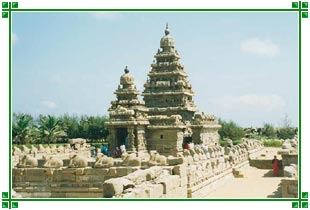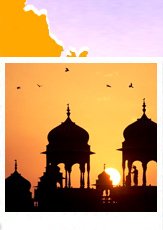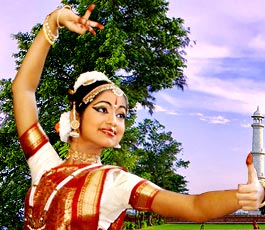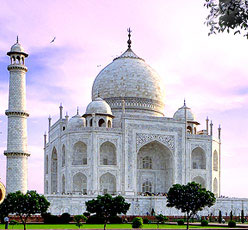 Tamil Nadu is often referred to as 'a land of temples' and Tamils are proud of the religious traditions and follow them strictly. The Tamils have been the greatest of temple builders and its rulers have always been the patrons of art and architecture including the Pallavas, Cholas and the Pandyas. The prominent Pallava temples of repute are the Shore Temple at Mamallapuram, The Kailashanathar Temple at Kanchipuram, the Vaikuntha Perumal Temple at Kanchipuram, and the Talagiriswara Temple at Kanchipuram. Cholas have a long list of significant contribution too including the Brihadishwara temples at Thanjavur and Gangaikonda Cholapuram, Airavatesvara temple at Darasuram and Kampaharesvara temple at Thirubuvanam. However, Pandyas not actually built so many temples as the Gopurams such as Sundara Pandya Gopuram that they added to the Jambukeshvara temple and the Eastern Gopuram at the Chidambaram temple. The other significant temples are said to be built by Nayaks of Madurai and Tanjavur such as the famous Ranganatha temple at Srirangam.
Tamil Nadu is often referred to as 'a land of temples' and Tamils are proud of the religious traditions and follow them strictly. The Tamils have been the greatest of temple builders and its rulers have always been the patrons of art and architecture including the Pallavas, Cholas and the Pandyas. The prominent Pallava temples of repute are the Shore Temple at Mamallapuram, The Kailashanathar Temple at Kanchipuram, the Vaikuntha Perumal Temple at Kanchipuram, and the Talagiriswara Temple at Kanchipuram. Cholas have a long list of significant contribution too including the Brihadishwara temples at Thanjavur and Gangaikonda Cholapuram, Airavatesvara temple at Darasuram and Kampaharesvara temple at Thirubuvanam. However, Pandyas not actually built so many temples as the Gopurams such as Sundara Pandya Gopuram that they added to the Jambukeshvara temple and the Eastern Gopuram at the Chidambaram temple. The other significant temples are said to be built by Nayaks of Madurai and Tanjavur such as the famous Ranganatha temple at Srirangam.Chayavaneshwara Temple:
2 miles from Tiruvengadu, the magnificent Chayavaneswara temple is situated at Chayavanam in the Chaikadu district of Tamil Nadu. Just a mile away from Kaveripatnam, the place where the River Cauvery meets the sea, it is an important pilgrimage centre for the Hindus. Held in much reverence and sanctity, the pilgrims visit this temple after ablution at the confluence to offer their homafe to the deity, Lord Chayavaneswara, and seek his blessings. It is said that the temple is closely connected with Iyarpagai Nayanar, one of the sixty-three Nayanmars (Saivite saints) of the South.
Krishnapuram Temple:
6 miles from Tirunelveli, Krishnapuram temple displays a sculptural splendor like none other. More than 300 years old, the figures in Arulnigu Venkatachalapati temple look as alive and young as ever. It is interesting to see that besides the usual statues of deities, the sculptures also depict scenes from the court life. Another unique feature of the temple is the musical pillars that emanate interesting sounds, when tapped. It encloses the temple of Lord Venkatachalapati installed here with amazing statues of Sri Devi and Bhoo Devi. The Mandam to the north of the temple is known as Veerappa Naick Mandapam with two beautifully carved elephants adorning its entrance. The six pillars at the Mandapam exhibit Puranic scenes with dexterity and look life-like.
Kumbeswara Temple:
The largest and the oldest Shiva temple at Kumbakonam is dedicated to Lord Kumbeswara and Goddess Sri Mangalambigai. The temple is an architectural and sculptural gem with a 128-ft high Gopuram carved intricately. It houses a shrine of Adi Vinayaka (Lord Ganesha) and Navarathri Mandapam that enshrines a single block of stone on which all the 27 stars and 12 Rashis (zodiacs) have been carved out. The temple also enshrines a rare specimen of the image of Lord Subrahmanya with six heads and six hands with different kinds of weapons. The temple also has an extensive collection of silver 'vahanas' (chariots) that are used carry the deities around at festival times.
Meenakshi Temple:
Madurai, the oldest and second largest city of Tamil Nadu, is built around the Sri Meenakshi Sundareswara temple in a lotus-shape. The interesting legend attached to Madurai goes like this. Built in magnificent Dravidian architectural style, the Meenakshi temple has a religious icon of South India and is known for its fantastic and splendid sculptures. The temple seems to be built between twelfth to the eighteenth century and has two main shrines, twelve Gopurams, a tank and innumerable Mandapas. Among the other Mandapas in the temple is the celebrated thousand pillared one.
Murugan Temple:
One of the 33 major temples of Tamil Nadu, the ancient temple of Lord Murugan at Tirupporur is 45 km from Chennai. It dates back to the times of Pallavas and is known by different names like Poriyur or Yuddhapuri or Samarapuri. There are many legends related to Tirupporur and one of them relates to Lord Shiva relieving Lord Vishnu and his consort Lakshmi from the curse of Kanva rishi. This Lord Shiva and his son Murugan are worshipped here. According to the Sthalapurana, it was here that Lord Murugan with his consorts Valli and Devayanai granted protection to the demi-gods and explained the true meaning of Pranava or the real truth to them and Agastya Muni.









